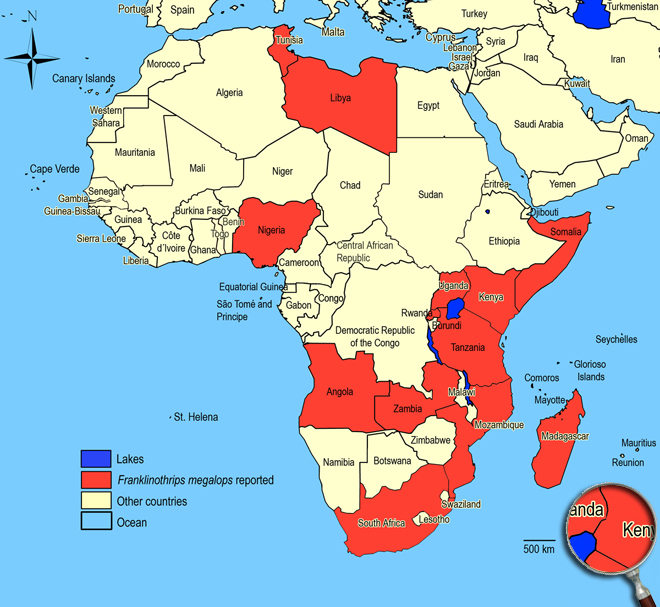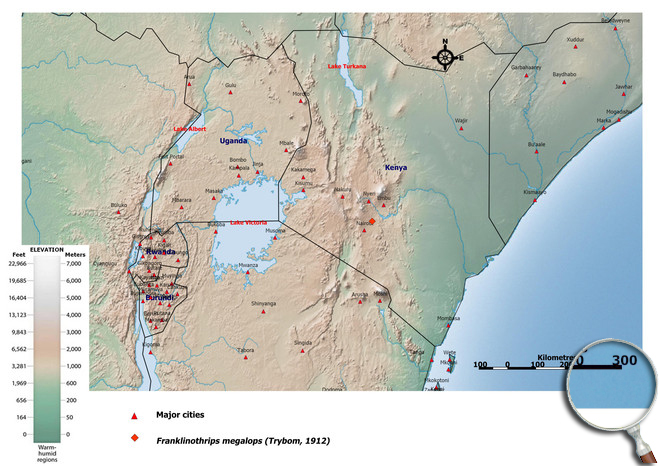Franklinothrips megalops (Trybom, 1912)
Aeolothripidae, Terebrantia, Thysanoptera
Figures
Fig. 1: 9-segmented antenna, terminal and basal segments
Fig. 2: Head dorsal with ocellar triangle and magnificent compound eyes
Fig. 3: Head, pro- and mesonotum
Fig. 4: Meso- and metanotum
Fig. 5: Fore wings
Fig. 6: Meso- and metasternum, abdominal segments 1-4
Fig. 7: Sternites V and VI (male)
Fig. 8: Sternites VII-X (male)
Introduction and recognition
Franklinothrips megalops is a generalist predator and attacks mainly other thrips, particularly Retithrips syriacus. Female macropterous and with a wasp-like waist. Body, legs and antennae brown except for antennal segments I-IV yellow with apex of IV brown, abdominal segments 1-4 largely yellow (3 & 4 with anterior margins brown), and segments 9 & 10 yellowish; abdominal segments 5-8 dark brown; fore wings banded, brown with a sub-basal pale area, a transverse white band medially, and a white spot near apex just within the dark costal ring-vein. Antennae 9-segmented, unusually elongate; segments III & IV exceptionally long and slender; III more than 3 times as long as II, and about 15 times as long as wide; segments III & IV with linear sensory areas extending into basal quarter of segment, these areas with characteristic scalloped margins (Fig. 1). Head and pronotum without long setae; head wider than long (Fig. 2 and 3), recessed into pronotum, eyes prolonged ventrally. Mesonotum with 1 pair of setae medially. Metanotum without sculpture medially, 1 pair of setae at anterior margin and 1 pair near posterior (Fig. 4). Tarsi 2-segmented, fore tarsus with a small terminal hamus that recurves to meet apex of a small seta. Fore wing slender with apex rounded, cross veins not distinguishable; costal margin with setae but no cilia (Fig. 5). Tergites with discal setae small; tergite X with pair of very small trichobothria. Sternites III-VI with 2 pairs of posteromarginal setae, and 2 pairs of discal setae laterally; VII with 4 pairs of posteromarginal setae, and 2 pairs of discal setae laterally (Fig. 6 and 7). Sexually dimorphic.
Males smaller than female; antennal segments II-IV yellow; pronotum smaller and paler than head; abdomen elongated (Fig. 8).
Taxonomic identity
Species
Franklinothrips megalops (Trybom, 1912)
Taxonomic history
Franklinothrips aureus Moulton, 1936
Spathiothrips bischoffi Richter, 1928
Franklinothrips myrmicaeformis Zanon, 1924
Mitothrips megalops Trybom, 1912
Common name
-
Present taxonomic position
Family: Aeolothripidae Uzel, 1895
Genus: Franklinothrips Back, 1912
Genus description
The genus Franklinothrips Back, 1912
Currently 14 species are placed in the genus Franklinothrips, all from tropical and subtropical countries, but more undescribed species are known from Southeast Asia (Mound & Reynaud 2005). Some of these species, particularly Franklinothrips megalops from Africa, are remarkably convincing ant-mimics, both in appearance and behaviour. All of them are probably predators, as adult and larvae, on other thrips or possibly mites and mostly live on the leaves of trees, although one common species in the Caribbean region lives on grasses. The genus includes some of the largest members of this family, but the wings are usually rather short and slender (Mound & Kibby 1998). Species of this genus have 9-segmented antennae, antennal segments are very long (III at least 8 times as long as wide), sensoria of antennal segments III and IV are either elongate and linear, and metanota have no sculpture medially.
Species description
Typical key character states of Franklinothrips megalops
Coloration and body sculpture
Body color: distinctively bicolored
Antennae
Number of antennal segments: 9
Form of sensorium on antennal segment III and IV: linear (gently undulated) along the segment
Length of antennal segment III: about 12 to 15 times as long as wide
Length of antennal segment V: much shorter than VI to IX together
Color of antennal segment IV: yellow or pale, apex slightly brown
Wings
Fore- and hind wings: present, more than half as long as abdomen
Fore- and hind wing surface: covered with microtrichia
Fore wing surface: not reticulate
Fore wing shape: apical third about one and a half to less than twice as wide as basal third or mainly parallel sided
Fringe cilia arising: from sockets
Fore wing veins: present
Number of cross veins: 2-3 (4)
Fringe cilia on posterior margin near apex: straight
Shape of fore wing apex: with continuous rounded margin
Fore wings: alternating bands of dark and light
Fore wing extreme apex color: dark
Abdomen
Ovipositor curved: upwards
Sternites IV, V and VI: with marginal setae and a few discal setae laterally
Median posterior marginal setae on sternite VII: without supernumerary setae arising in front of marginal setae
Color of abdominal segments 1 to 4: largely yellow
Abdominal segment 10: never tubular, longitudinally incomplete ventrally in both sexes

Similar or related species
Compared to females of Franklinothrips megalops with abdominal segments 1-4 largely yellow, in females of Franklinothrips vespiformis the abdominal segment 4 is uniformly dark brown in contrast to yellow segments 1-3. Females of Franklinothrips megalops have antennal segments I-IV yellow with apex of IV brown, unlike Franklinothrips vespiformis with antennal segments I-III yellow and IV dark brown.
Species of Franklinothrips differ from Aeolothrips and Allelothrips in having a metanotum without sculpture medially (metanotum of Allelothrips has a distinctive triangular area of striate sculpture; Aeolothrips fasciatus has the metanotal median area with irregular equiangular reticulation), antennal sensoria on segments III & IV that are linear with scalloped margins (those of Allelothrips species and Aeolothrips fasciatus are linear and simple but without scalloped margins), and 2 pairs of posteromarginal setae on sternites III-VI and 4 pairs of posteromarginal setae on sternites VII (Allelothrips species possess 4 pairs of posteromarginal setae on sternites III-VII; Aeolothrips fasciatus with 4 pairs of posteromarginal setae on sternites III-VII, and 2 pairs of supernumerary setae anterior to marginal setae S1 and S2 on sternit VII). Compared to Aeolothrips fasciatus, species of Allelothrips and Franklinothrips have discal setae laterally on sternites II-VII (Aeolothrips fasciatus without discal setae on sternites).
Biology
Life history
At 25°C total development from egg to adult took between 2 and 3 weeks (Sureshkumar & Ananthakrishnan 1987).
Host plants
The plants on which Franklinothrips megalops are found in association with prey are varied and include indigenous trees like shiny-leaf buckthorn (Rhamnus prinoides), lavender tree (Heteropyxis natalensis), water berry (Syzygium cordatum) and economically important crops as beans (Phaseolus vulgaris), citrus (Citrus spp.) and coffee (Coffea arabica).
Vector capacity
None identified
Damage and symptoms
-
Detection and control strategies
-
.
Additional notes
Adults and larvae are actively predaceous and attack mainly other thrips species like greenhouse thrips Heliothrips haemorrhoidalis, Thrips palmi, redbanded thrips Selenothrips rubrocinctus, chili thrips Scirtothrips dorsalis, and castor thrips Retithrips syriacus (Hoodle et al. 2000; Palmer 1990).
Biogeography
North and South Africa, India, Palestine. Angola,
Kenya (Thika, Kibwezi),
Libya,
Madagascar,
Mozambique (Chai Chai, Maputo),
Nigeria,
Rwanda,
Somalia,
South Africa (Gauteng: Pretoria, Wyllie's Poort; Limpopo: Tzaneen, Pietersburg, Salique Forest Station, Marieps, Zebediela; North West: Rustenburg; KwaZulu-Natal: Richards Bay, Durban; Western Cape: Mossel Bay, Worcester), Tanzania, Tunisia, Uganda, Zambia, Zimbabwe.
African countries where Franklinothrips megalops has been reported

Occurence of Franklinothrips megalops in East Africa

Please click here for survey sites of all observed thrips species of Kenya, Tanzania and Uganda.
Click here for locations of Franklinothrips megalops in parts of East Africa.

Bibliography
Bagnall RS (1913). Notes on Aeolothripidae, with description of a new species. Journal of Economic Biology. 8: 155-158
Bagnall RS (1913). A synopsis of the thysanopterous family Aeolothripidae. 2nd International Congress of Entomology, Oxford, August 1912. Vol. 2, Transaction, pp. 394-397
Bagnall RS (1915). On a collection of Thysanoptera from the West Indies, with descriptions of new genera and species. Journal of the Linnean Society, Zoology. 32 (220): 495-507
Bagnall RS (1926). The family Franklinothripidae nov., with description of a new type of Thysanopteron. Annals and Magazine of Natural History, Zoology, Botany and Geology. (Serie 9) 17: 168-173
Bagnall RS (1927). Contributions towards a knowledge of the European Thysanoptera. II. Annals and Magazine of Natural History, Zoology, Botany and Geology. (Serie 9) 19: 564-575
Bagnall RS (1931). On the Aeolothripid - complex and the classification of the suborder Terebrantia (Thysanoptera). Bulletin de la Société des Naturalistes Luxembourgeois. 41: 115-118
Hartwig EK (1952). Taxonomic studies of South African Thysanoptera, including genitalia, statistics and a revision of Trybom's types. Entomology Memoirs. 2 (11): 340-499
Hoddle MS, Robinson L, Drescher K & Jones J (2000). Developmental and reproductive biology of a predatory Franklinothrips n. sp. (Thysanoptera: Aeolothripidae). Biological Control. 18: 27-38
Hood JD (1915). On some American Aeolothripidae (Thysanoptera). Entomological News, and Proceedings of the Entomological Section of the Academy of Natural Sciences of Philadelphia. 26: 162-166
Moritz G (2006). Thripse. Pflanzensaftsaugende Insekten, Bd. 1, (1. Auflage). Westarp Wissenschaften, Hohenwarsleben, 384 pp. ISBN 13: 978 3 89432 8917
Moulton D (1936). Thysanoptera from Africa. Annals and Magazine of Natural History, Zoology, Botany and Geology. (Serie 10) 17: 493-509
Mound LA & Kibby G (1998). Thysanoptera: An identification guide, (2nd edition). CAB International, Wallingford and New York, 70 pp
Mound LA & Reynaud P (2005). Franklinothrips; a pantropical Thysanoptera genus of ant-mimicking obligate predators (Aeolothripidae). Zootaxa. 864: 1-16
Palmer JM (1990). Identification of the common thrips of Tropical Africa (Thysanoptera, Insecta). Tropical Pest Management. 36 (1): 27-49
Pitkin BR & Mound LA (1973). A catalogue of West African Thysanoptera. Bulletin de ľInstitut Fondamental ďAfrique Noire, Série A. 35 (2): 407-449
Richter W (1928). Beitrag zur Kenntnis der Aeolothripiden (Thysanoptera). Deusche Entomologische Zeitschr. (1) 29-37
Stannard LJ (1952). Phylogenetic studies of Franklinothrips (Thysanoptera: Aeolothripidae). Journal of the Washington Academy of Sciences. 42: 14-23
Sureshkumar N & Ananthakrishnan TN (1987). Biotic interactions in relation to prey-predator relationship with special reference to some thrips species (Thysanoptera: Insecta). Journal of Entomological Research. 11: 192-202
Trybom F (1912). Mitothrips, eine neue Physapoden-Gattung aus Britischen Ostafrika. Entomologisk Tidskrift. 33: 145-151
zur Strassen R (1959). Three species of Thysanoptera from Glorioso Island near Madagascar. Journal of the Entomological Society of Southern Africa. 22 (2): 390-393
zur Strassen R (1960). Catalogue of the known species of South African Thysanoptera. Journal of the Entomological Society of Southern Africa. 23 (2): 321-367
zur Strassen R (1968). New records of South African Thysanoptera with description of a new Phlaeothripid genus. Journal of the Entomological Society of Southern Africa. 31 (2): 365-372
zur Strassen R (2000). Thysanopterologische Notizen (7) (Thysanoptera, Terebrantia). Entomologische Nachrichten und Berichte. 44: 25-34
zur Strassen R (2003). Die terebranten Thysanopteren Europas und des Mittelmeer-Gebietes. Die Tierwelt Deutschlands und der angrenzenden Meeresteile nach ihren Merkmalen und nach ihrer Lebensweise, 74. Teil. Goecke & Evers, Keltern, Germany, 277 pp
----
Web links
Mound´s Thysanoptera pages
Thysanoptera Checklist
ICIPE Thrips survey sites
UNI Halle & Thrips sites
Thrips of California












